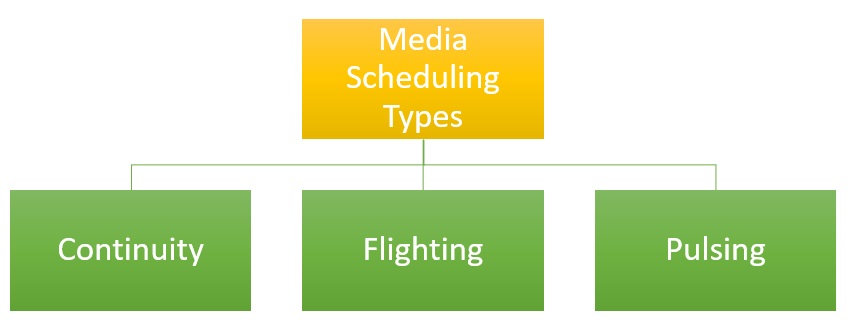- Business Concepts ›
- Marketing and Strategy ›
- Media Scheduling
Media Scheduling
Definition, Types, Factors & Example
This article covers meaning & overview of Media Scheduling from marketing perspective.
What is meant by Media Scheduling?
Media Scheduling refers to the pattern of timing of an advertising which is represented as plots on a flowchart on a yearly basis. The plots in the flowchart indicate the pattern of periods that matches with favorable selling period. The classical scheduling models are commonly known as continuity, fighting and pulsing.
Media Scheduling Factors
These depends upon a number of factors such as:
1. Nature of product- whether it is consumer usable, durables or industrial
2. Nature of sales- whether the sales is seasonal or regular
3. Product lifecycle- whether the product introduction is in growth, maturity or decline
4. Pattern of competitor’s programs
5. Entry of new competitors in the market
6. Availability of funds for advertising and marketing campaigns
Types of Media Scheduling Models
There are mainly three types of media scheduling models names continuity, flighting & pulsing, which are discussed as below.

Continuity
Continuity model focus on products which are not affected by seasonality. These products can be advertised continuously with minimum changes to the overall campaign during a period. The campaigns can be run over a period with short gaps. Packaged goods & services can be promoted using a continuous media campaign over a period of time.
Flighting
This model focuses on certain seasons of advertising where the product or service usage is of more utility. In this model, there are periods of advertising in a year followed by months when there is no promotion required. A lot of seasonal products which are dependent on different seasons, festivities etc. can be promoted using this technique.
Pulsing
Pulsing focuses on limited promoted for most of the time period but on certain occasions the advertising spends are increased manifold. Most of these products are those which are sold normally throughout the year based on need, but there are short periods where needs increase significantly. That is when media spends are increased to ensure more promotion and more sale.
Example of Media Scheduling
A few examples based on the types of media scheduling models are mentioned as below:
1. Continuity: Media campaigns for regular products like shampoo, toothpaste, soap etc.
2. Flighting: Media campaigns for a specific time period like raincoat during monsoons, woolens during winters, ACs during summers etc.
3. Pulsing: These campaigns are usually associated with a launch of new product like new phone, launch of a car etc. or with products which are sold throughout but promoted aggressively for a specific season like talcum powders for summers.
Hence, this concludes the definition of Media Scheduling along with its overview.
This article has been researched & authored by the Business Concepts Team which comprises of MBA students, management professionals, and industry experts. It has been reviewed & published by the MBA Skool Team. The content on MBA Skool has been created for educational & academic purpose only.
Browse the definition and meaning of more similar terms. The Management Dictionary covers over 1800 business concepts from 5 categories.
Continue Reading:
What is MBA Skool?About Us
MBA Skool is a Knowledge Resource for Management Students, Aspirants & Professionals.
Business Courses
Quizzes & Skills
Quizzes test your expertise in business and Skill tests evaluate your management traits
Related Content
All Business Sections
Write for Us